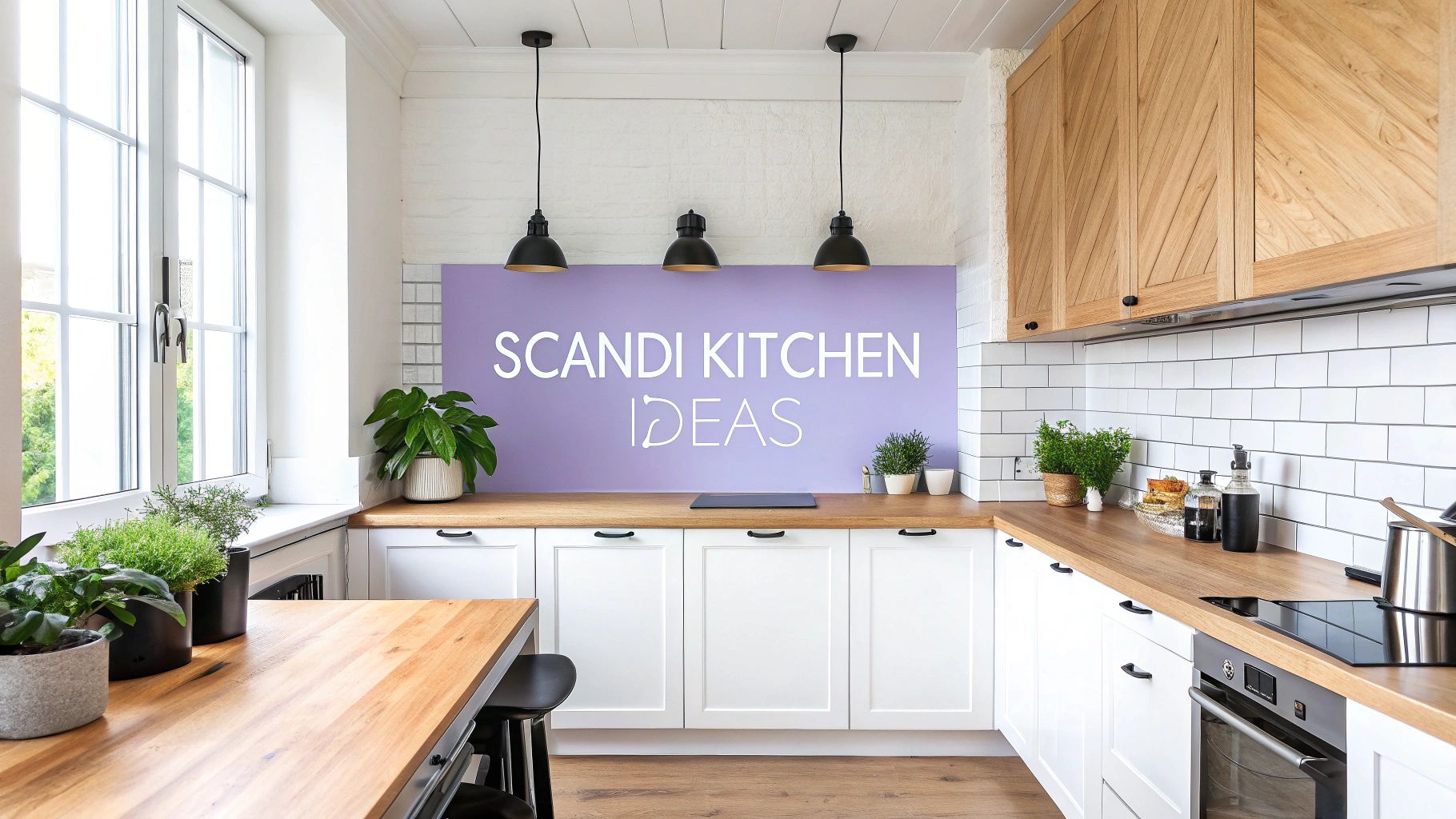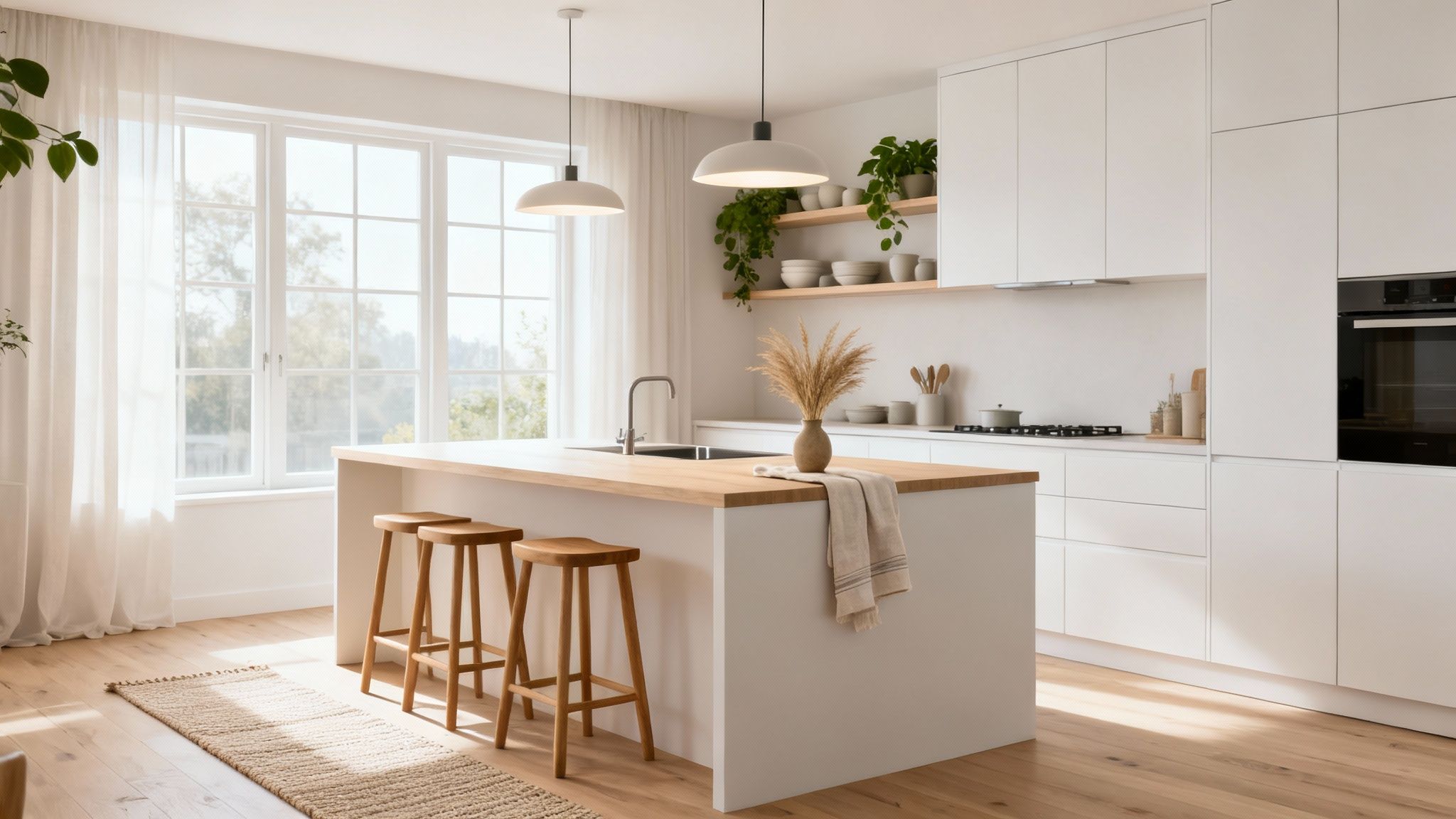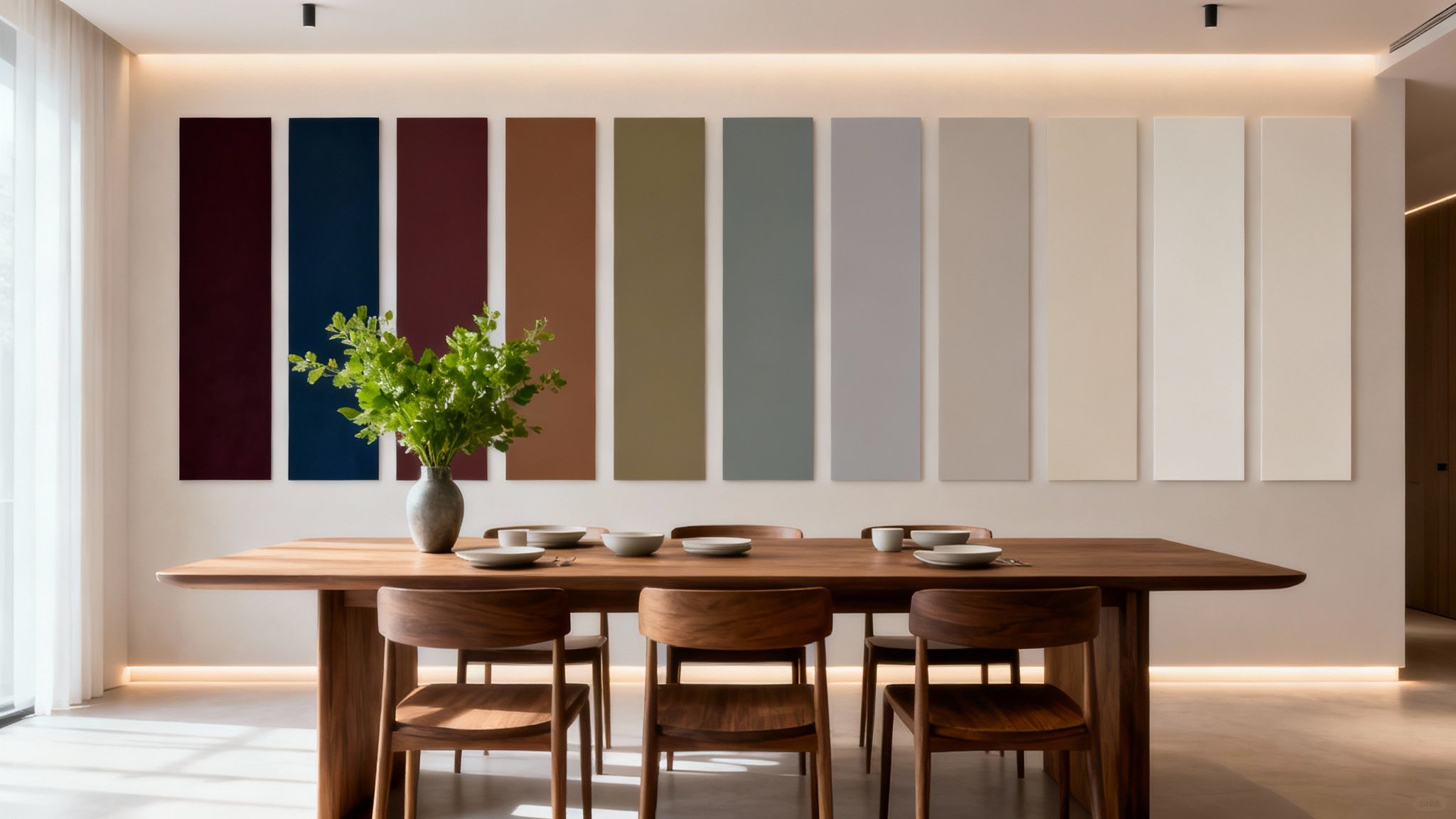The Scandinavian design ethos, rooted in simplicity, functionality, and a deep connection to nature, has long been a benchmark for timeless home interiors. Nowhere is this more apparent than in the heart of the home: the kitchen. A Scandi style kitchen is more than just a trend; it's a commitment to uncluttered living, where every element has a purpose and contributes to a serene, light-filled atmosphere.
In this guide, we explore eight distinct yet interconnected approaches to achieving this coveted aesthetic. We move beyond generic advice, providing actionable insights, specific material suggestions, and layout strategies to help you design a space that is both beautiful and practical. From the clean lines of minimalism to the inviting warmth of natural wood, we will break down the core components that define Nordic kitchen design.
Whether you're planning a full renovation or seeking inspiration to refresh your current space, these ideas will equip you with the knowledge to create a functional sanctuary. Our focus is on embodying the principles of 'hygge' – a quality of cosiness and comfortable conviviality that engenders a feeling of contentment in your home. Let’s explore how to bring this calming and organised style to life.
1. The Minimalist White Kitchen with Clean Lines
At its core, the Scandi style kitchen is an exercise in restraint and functionality, and no design embodies this philosophy more than the minimalist white kitchen. This approach is built on a foundation of clean, uninterrupted lines, predominantly white cabinetry, and an uncluttered atmosphere that feels both serene and highly practical. The absence of elaborate ornamentation places the focus squarely on the quality of materials and the intelligence of the layout, creating a calm, bright, and efficient culinary space.
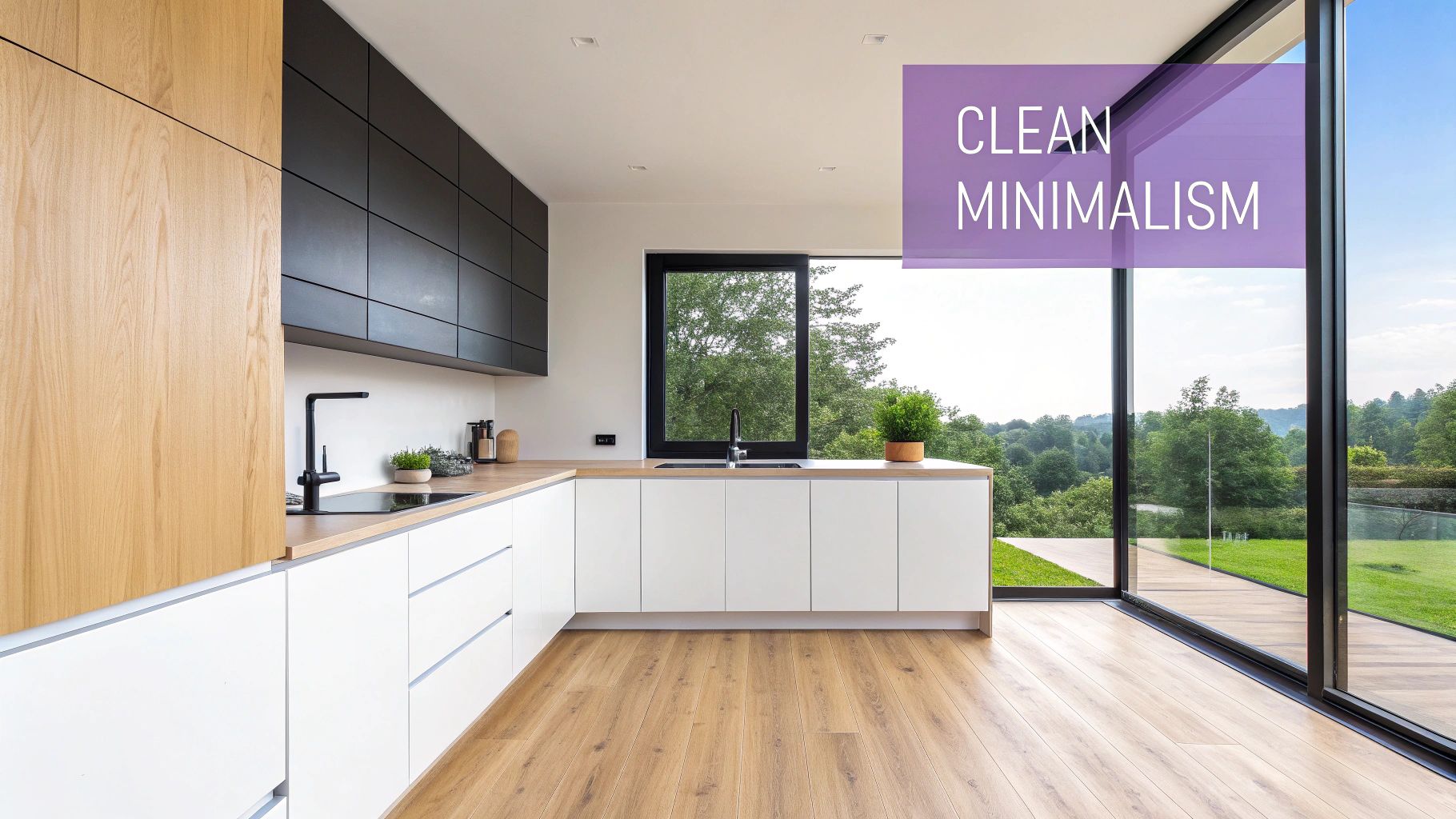
This design ethos has been popularised by brands like IKEA, with its accessible Voxtorp systems, and high-end design houses such as SieMatic and Boffi, which champion handleless forms. The principle is simple: create a visually quiet canvas that maximises natural light and promotes a sense of order.
Why This Design Works
A minimalist white kitchen is the perfect solution for small or dimly lit spaces, as the white surfaces reflect light, making the room feel larger and more open. It provides a timeless backdrop that won't fall out of fashion, allowing you to easily update its look with new accessories over the years. By prioritising simplicity, you create an environment free from visual distractions, which can make the daily ritual of cooking a more mindful and calming experience.
How to Achieve This Look
- Introduce Subtle Texture: An all-white scheme can feel clinical without texture. Prevent this by incorporating natural materials. Think of a durable quartz worktop with a faint marble vein, a pale oak floor to add warmth underfoot, or a backsplash of handmade zellige tiles with slight variations in tone.
- Incorporate Smart Lighting: Lighting is crucial for adding warmth and depth. Install warm-toned LED strips under upper cabinets to illuminate your work surfaces. Consider adding integrated lighting inside glass-fronted cabinets to create a gentle, ambient glow in the evenings.
- Focus on Quality Hardware: In a minimalist design, every detail counts. If you opt for handles or knobs instead of a handleless design, choose simple, high-quality pieces in materials like brushed brass or matt black. Their quality will be immediately noticeable against the simple backdrop.
- Add Touches of Green: Life and colour can be introduced simply. A small row of potted herbs like basil or mint on the windowsill adds a touch of organic beauty and is also practical for cooking.
2. Light Wood and Natural Materials Integration
While minimalism forms the backbone of Scandi design, its soul is found in the deep connection to nature. This philosophy comes to life through the integration of light woods and other organic materials, which introduce warmth, texture, and a sense of grounding to the kitchen. This approach masterfully balances the crisp coolness of typical white or neutral palettes with the inviting tones of woods like pale oak, birch, or ash, creating a harmonious and tactile environment that feels both modern and deeply comforting.
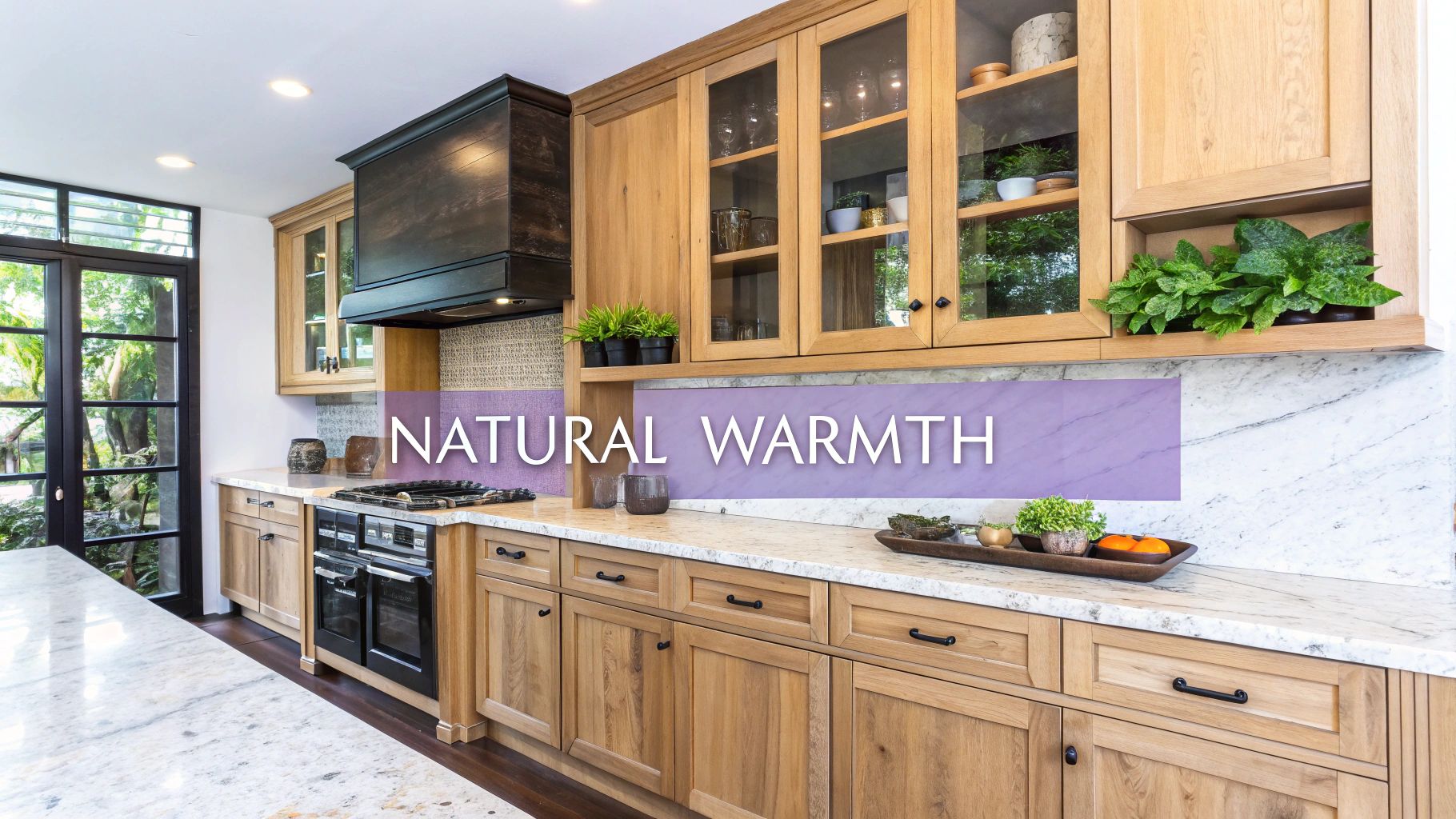
This warm interpretation of the scandi style kitchen is beautifully showcased by high-end Swedish kitchen makers like Kvänum, who champion natural wood cabinetry. It's also evident in the accessory lines from brands such as Muuto and Normann Copenhagen, whose wooden utensils and decorative objects celebrate the beauty of raw materials. The goal is to create a space that feels calm and connected to the natural world.
Why This Design Works
Integrating natural wood is the perfect way to prevent a minimalist kitchen from feeling stark or uninviting. The grain and tone of timber add visual interest and a layer of organic complexity that is inherently calming. This design is highly versatile, suiting everything from a rustic country cottage to a sleek urban apartment, as it softens modern lines and adds timeless character. It creates a space that isn't just for cooking but for living and gathering.
How to Achieve This Look
- Balance Wood with Neutrals: To maintain the bright, airy feel of a scandi style kitchen, balance significant wood elements like cabinets or flooring with large areas of white or soft grey. This could be white walls, a pale quartz worktop, or simple white splashback tiles.
- Layer Wooden Textures: Don’t be afraid to mix different wood tones and finishes for added depth. Pair pale oak flooring with slightly darker birch cabinetry or display a collection of acacia and beech cutting boards against the wall. This layered approach feels authentic and collected over time.
- Seal Surfaces for Durability: When using wood for worktops or high-traffic areas, ensure it is properly sealed with a food-safe, matt-finish varnish or oil. This protects the timber from stains and moisture while preserving its natural look and feel.
- Decorate with Natural Elements: Functional items can double as décor. Display beautifully crafted wooden utensils in a ceramic pot, use wooden cutting boards as serving platters, or add a statement wooden pendant light over the dining area. These small touches reinforce the natural aesthetic, and you can discover more affordable home décor ideas on sprucecollective.co.uk to complement this style.
3. Open Shelving and Display Storage
A defining characteristic of the Scandi style kitchen is the move away from heavy, wall-to-wall upper cabinets in favour of open shelving. This design choice is rooted in the Scandinavian principles of functionality and accessible beauty. By replacing traditional cupboards with floating shelves, you reduce visual bulk, making the kitchen feel more spacious and airy. It also transforms everyday items like crockery, glassware, and spices into curated decorative displays.

This approach has been championed by iconic Scandinavian brands like String Furniture, with their versatile and modular String Pocket shelving systems, and HAY, whose minimalist brackets are a favourite among design enthusiasts. The core idea is to celebrate the objects we use daily, keeping them within easy reach while contributing to the room's aesthetic. This blend of practicality and personality is what makes the Scandi style kitchen so inviting.
Why This Design Works
Open shelving forces a mindful approach to what you own, encouraging you to keep only the items you truly love and use. It's an excellent strategy for displaying beautiful ceramics or glassware that would otherwise be hidden away. This creates a lived-in, personal atmosphere that feels authentic and welcoming. Furthermore, it allows natural light to travel more freely around the room, enhancing the sense of space and brightness.
How to Achieve This Look
- Curate with Cohesion: For a harmonious look, stick to a limited colour palette for your displayed items. Grouping matching dishes, glassware, and storage jars creates a clean, organised feel. Decant dry goods like pasta and flour into uniform glass containers.
- Balance Form and Function: Place your most frequently used items, like coffee mugs and everyday plates, on the most accessible lower shelves. Reserve higher shelves for more decorative pieces, such as a shapely vase or a small trailing plant.
- Mix Materials for Interest: While the items on the shelves should be cohesive, the shelving itself can introduce texture. Consider shelves made from pale oak or ash to add warmth against a tiled backsplash, or choose sleek, powder-coated metal shelves for a more industrial edge.
- Avoid Overcrowding: The key to successful open shelving is restraint. Leave some empty space on each shelf to allow items to breathe. This negative space is crucial for preventing the display from looking cluttered and chaotic.
4. Neutral Colour Palette with Subtle Texture
While stark white is a hallmark of Scandinavian design, a softer and more layered approach involves using a neutral colour palette enriched with subtle texture. This design philosophy moves beyond pure minimalism to create a space that feels warm, inviting, and deeply connected to nature. It relies on a restrained scheme of whites, greys, beiges, and muted earth tones, using textural variations to build depth and prevent the look from feeling flat.
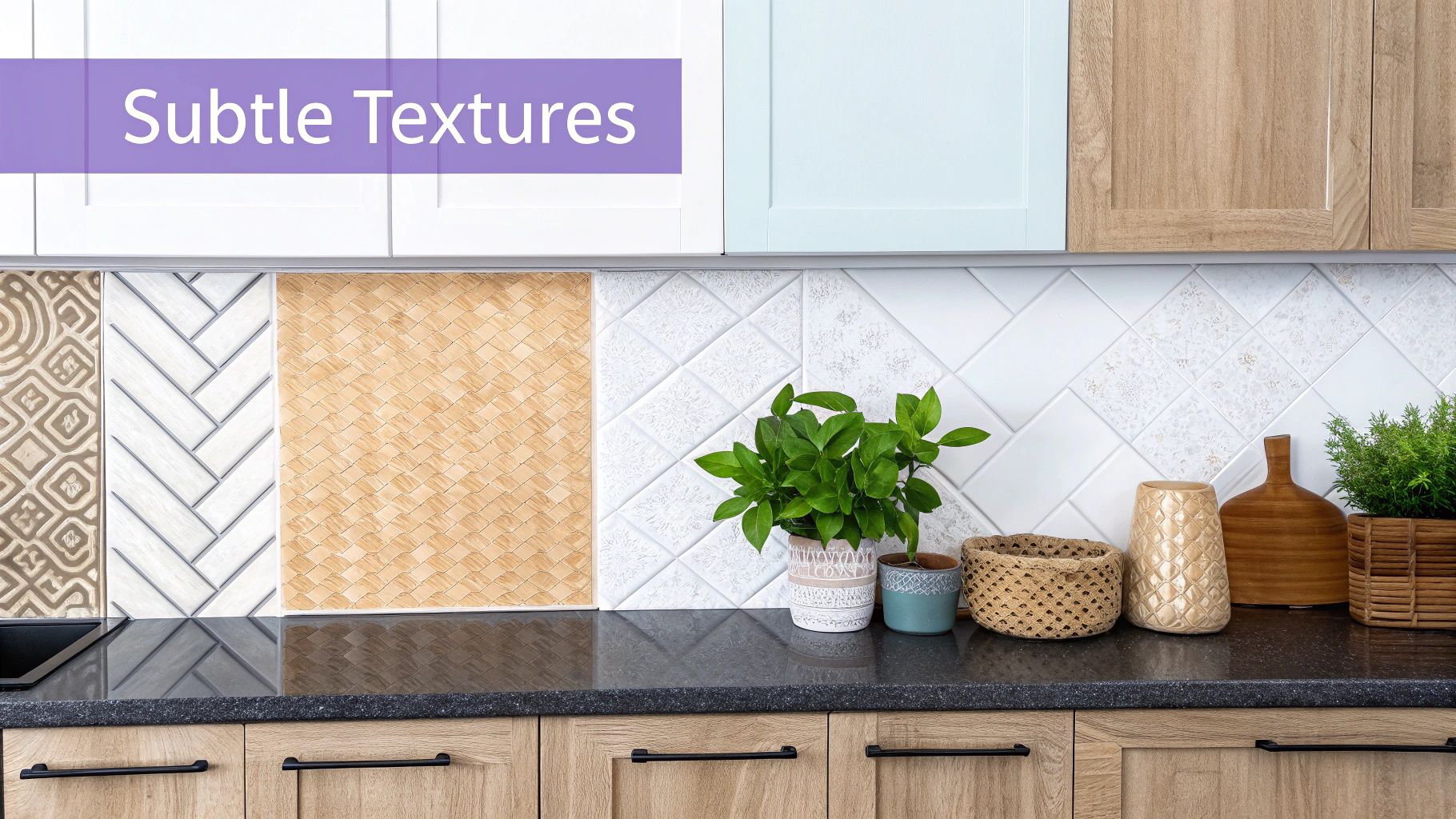
This textural and tonal approach is championed by design studios like Norm Architects and Note Design Studio, which are known for creating serene yet characterful interiors. The goal is to create a calm, cohesive environment where the interplay of light and surface becomes the main feature, elevating the scandi style kitchen into a sophisticated and sensory experience.
Why This Design Works
A neutral, textural kitchen offers a perfect balance between minimalist principles and homely comfort. It provides a warm, organic feel that is less stark than an all-white scheme while remaining bright and uncluttered. This approach is incredibly versatile, suiting both modern and more traditional homes, and creates a timeless foundation that can be easily adapted. The focus on texture adds a layer of visual interest that engages the senses and makes the space feel thoughtfully curated.
How to Achieve This Look
- Layer Different Textures: The key to this look is layering. Combine smooth, matt-finish cabinetry with a subtly grained natural stone worktop from a brand like Caesarstone. Contrast this with a backsplash of glossy, imperfect subway tiles and perhaps some woven bar stools or a linen Roman blind.
- Use Lighting to Highlight Texture: Direct your lighting strategically to accentuate the different surface finishes. Use under-cabinet lighting to cast a glow across a textured splashback, or position a pendant light to highlight the grain of a wooden dining table. The shadows created will enhance the room's depth.
- Incorporate Material Contrast: Blend different materials within the same neutral colour family. Think of pairing pale grey microcement flooring with light oak cabinets and brushed stainless steel taps. This contrast in materiality adds quiet sophistication without introducing loud colours.
- Add Sparingly Used Accent Colours: While the palette is neutral, a single, carefully chosen accent can be powerful. A muted sage green on a feature wall, a collection of terracotta pots, or dark bronze cabinet handles can provide a focal point without disrupting the overall calm.
5. Functional Island with Integrated Seating
The kitchen island is the social and functional heart of a modern home, and in a Scandi style kitchen, it is elevated to an art form of efficiency and sociability. This approach focuses on creating a central unit that is more than just a worksurface; it's a multifunctional hub for food preparation, informal dining, and clever storage. The design prioritises clean lines and integrated seating to maintain the kitchen's streamlined aesthetic, transforming it into a natural gathering point without sacrificing its uncluttered feel.
This philosophy is championed by premium brands like Bulthaup, with their seamless b3 islands, and the modular systems from Vipp, which treat the island as a piece of functional furniture. The key is creating a single, cohesive element that serves every need, from housing a sink or hob to providing a comfortable spot for morning coffee, embodying the Scandi principles of practicality and community.
Why This Design Works
A multifunctional island is the ultimate space-saving solution, combining cooking, dining, and socialising into one efficient footprint, which is ideal for open-plan living. It creates a natural flow, allowing the cook to remain part of the conversation while preparing a meal. This design enhances the kitchen's role as the central hub of the home, encouraging interaction and making the space feel more connected and alive. It organises the room's traffic and provides a clear, purposeful centrepiece.
How to Achieve This Look
- Plan for Proper Clearance: Functionality is paramount. Ensure there is at least 90-100cm (approximately 36-42 inches) of clearance around the island to allow for comfortable movement, opening cabinet doors, and pulling out chairs without obstruction.
- Choose Tuck-Under Stools: To maintain the clean, minimalist lines of your scandi style kitchen, select bar stools that can be tucked completely under the counter overhang when not in use. Simple, backless designs in light wood or slender metal frames work best.
- Integrate Task Lighting: Illuminate the island effectively with dedicated task lighting. A trio of simple, elegant pendant lights or a single linear suspension light hung centrally above the island provides focused light for tasks and creates a stylish focal point.
- Consider Utilities Early: If you plan to include a sink, hob, or electrical outlets in your island, these services must be planned for at the very beginning of the design process. Integrating them seamlessly is crucial for achieving a clean, uncluttered finish.
6. Statement Pendant Lighting
In a Scandi style kitchen, lighting transcends mere utility to become a central design feature. Statement pendant lights serve as both functional task lighting over an island or dining table and as sculptural art pieces. These fixtures often embody Scandinavian design principles with their clean geometric shapes, innovative use of natural materials, and an elegant simplicity that enhances the kitchen's minimalist aesthetic without overwhelming it. They provide focused, effective illumination while acting as a striking visual anchor.
This approach has been championed by iconic lighting designers like Louis Poulsen, whose layered PH series pendants are masterpieces of glare-free light. Modern brands such as Muuto, with its tactile Unfold pendant, and Tom Dixon, known for the sculptural Beat lights, continue this tradition of creating lights that are as beautiful as they are functional, making them a cornerstone of contemporary Nordic interiors.
Why This Design Works
Statement lighting is a powerful tool for adding personality and a focal point to an otherwise understated kitchen. A well-chosen pendant can introduce a pop of colour, a unique texture, or a compelling shape that draws the eye and elevates the entire design scheme. It allows you to express individual style while adhering to the core tenets of functionality and uncluttered design that define the Scandi look. For more inspiration, you can discover a wide range of lighting ideas for your home.
How to Achieve This Look
- Mind the Height and Scale: Hang pendants so the bottom of the fixture is approximately 75-90 cm (30-36 inches) above your worktop or island. This provides ample illumination without obstructing views. Ensure the fixture's scale is proportionate to the space; a large island can handle a substantial pendant or a group of smaller ones.
- Cluster in Odd Numbers: For a visually pleasing arrangement over a kitchen island or dining table, group pendants in odd numbers like three or five. This creates a dynamic, balanced composition that feels more natural and less rigid than an even-numbered pairing.
- Install Dimmer Switches: Control is key to creating the right atmosphere. Installing a dimmer switch allows you to adjust the light intensity from bright, functional task lighting for cooking to a soft, ambient glow for dining or relaxing, enhancing the kitchen’s versatility.
- Complement Your Materials: Choose a pendant that harmonises with other elements in your kitchen. A matt black metal fixture can echo black hardware, while a light oak pendant can tie in with wooden flooring or bar stools, creating a cohesive and thoughtfully curated space.
7. Indoor Plants and Natural Elements
The connection to nature is fundamental to the Scandinavian way of life, and this principle extends deeply into home design. Bringing indoor plants and other natural elements into the kitchen introduces life, texture, and organic softness, beautifully contrasting the clean lines and neutral colours typical of a Scandi style kitchen. This biophilic approach not only enhances the aesthetic but also promotes a sense of wellbeing and calm, turning the kitchen into a restorative, living space.
This emphasis on greenery and nature has been heavily featured in lifestyle publications like Kinfolk and popularised by Nordic interior designers and bloggers. The idea is to blur the line between indoors and outdoors, creating a kitchen environment that feels fresh, vibrant, and deeply connected to the natural world.
Why This Design Works
Incorporating plants is a simple yet powerful way to add colour and vitality without compromising the minimalist ethos. They act as living sculptures, purifying the air and adding a dynamic, ever-changing element to the room. This approach is perfect for preventing a neutral-toned kitchen from feeling stark or clinical, infusing it with warmth and personality that is both authentic and effortless.
How to Achieve This Look
- Select Suitable Plants: Choose hardy, low-maintenance plants that thrive in kitchen conditions. A trailing Pothos or Philodendron looks stunning cascading from an open shelf, while a resilient Snake Plant in a modern planter adds vertical interest.
- Create a Functional Herb Garden: A windowsill herb garden is a classic Scandi feature that is both beautiful and practical. Plant pots with basil, rosemary, and thyme to add fresh flavours to your cooking and a wonderful aroma to your kitchen.
- Use Cohesive Planters: Maintain a clean, organised look by using planters in similar materials or colours. Simple terracotta, ceramic, or concrete pots in white, grey, or black complement the Scandinavian aesthetic perfectly. You can learn more about how natural elements make a room cosy for additional ideas.
- Position for Light and Health: Place plants where they will receive adequate natural light, such as near a window or under a skylight. Remember to rotate them occasionally to ensure even growth and keep them looking their best.
8. Integrated Appliances and Hidden Storage
A hallmark of the quintessential Scandi style kitchen is its seamless and uncluttered appearance, a feat achieved largely through the clever use of integrated appliances and hidden storage. This design philosophy conceals modern technology behind custom cabinetry panels, ensuring that functional items like dishwashers, refrigerators, and extractor fans do not disrupt the clean, continuous lines of the space. The result is a kitchen that feels less like a utility room and more like a tranquil, cohesive part of the living area.
This approach has been perfected by premium appliance manufacturers such as Miele and Bosch, whose built-in ranges are designed to disappear into their surroundings. Brands like Sub-Zero offer high-performance integrated refrigeration that merges flawlessly with bespoke joinery. The objective is to maintain a serene visual flow, where the function is ever-present but never visually intrusive.
Why This Design Works
Integrating appliances is the ultimate solution for achieving a truly minimalist aesthetic. It eliminates the visual clutter of mismatched machines and stainless steel fronts, creating a calm and unified look. This is especially effective in open-plan living spaces, where the kitchen needs to blend harmoniously with dining and relaxation areas. Hidden storage, like pull-out larders or corner carousels, maximises every inch of space, keeping worktops clear and reinforcing the Scandinavian principles of order and efficiency.
How to Achieve This Look
- Plan Ahead for Services: The successful integration of appliances relies on meticulous planning. Ensure that electrical and plumbing points are precisely positioned during the early stages of a renovation to align with your cabinetry layout. Always consider future service access for maintenance and repairs.
- Opt for Consistent Branding: When possible, choose integrated appliances from the same manufacturer or series, such as the Bosch Benchmark line. This ensures consistent dimensions, controls, and performance, which simplifies the installation process for your kitchen fitter and creates a more cohesive user experience.
- Prioritise Proper Ventilation: Integrated appliances, especially refrigerators and ovens, generate heat. Work with your designer to incorporate necessary ventilation grilles or channels within the cabinetry design, often cleverly hidden in the plinth or above units, to ensure longevity and safe operation.
- Maximise Internal Organisation: Behind the calm exterior, clever organisation is key. Utilise internal drawer dividers, pull-out pantry systems, and hidden drawers within larger units to create a designated home for every item, making the kitchen as functional as it is beautiful.
8-Key Features Comparison of Scandi Kitchens
Crafting Your Personal Scandi Sanctuary
As we have journeyed through the serene and functional world of Scandinavian design, it has become clear that crafting the perfect Scandi style kitchen is not about following a rigid set of rules. Instead, it is an artful process of balancing core principles to create a space that feels both aspirational and deeply personal. It is about distilling the essence of hygge and lagom into the heart of your home, creating a sanctuary that is as beautiful as it is practical.
The designs we've explored, from minimalist all-white schemes to those rich with light wood and natural textures, all share a common DNA. They prioritise clean lines, celebrate uncluttered surfaces, and embrace the calming influence of nature. This shared foundation is what makes the Scandi aesthetic so enduringly popular and adaptable.
Key Takeaways for Your Kitchen Transformation
To truly master this style, remember to synthesise the key elements we've discussed. It is the interplay between these ideas that creates a cohesive and inviting atmosphere.
- Functionality First: Begin with the layout. An efficient workflow, as seen in the functional island and integrated appliance examples, is paramount. A beautiful kitchen that is difficult to use misses the fundamental point of Scandinavian design.
- A Foundation of Light and Nature: Build your palette around a neutral base and introduce warmth through natural materials. The combination of crisp whites, soft greys, and warm woods is the cornerstone of a successful Scandi style kitchen.
- Curated Personalisation: Use open shelving and statement lighting not just as functional items, but as opportunities for expression. Display cherished ceramics, unique glassware, and bring in greenery to add life and personality. This prevents the minimalist aesthetic from feeling sterile.
Your Actionable Next Steps
Embarking on your own kitchen project can feel daunting, but breaking it down into manageable steps makes the process achievable. Start by identifying which core Scandi principles resonate most with you. Are you drawn to the absolute simplicity of hidden storage, or do you prefer the curated look of open displays?
Once you have a clear vision, begin sourcing materials and planning your layout. Focus on quality over quantity. A single, beautifully crafted wooden countertop or a set of elegant pendant lights can have a more significant impact than a dozen lesser additions. Remember to measure your space carefully and consider how you and your family will use it daily. This practical approach ensures your finished Scandi style kitchen will be a space you love for years to come. Ultimately, this journey is about creating a room that supports your lifestyle, calms your mind, and brings a touch of timeless Nordic elegance into your everyday life.

